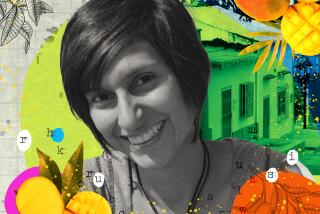Media : The Man Behind ‘Monica’ : * Brazil’s Mauricio de Sousa is the jet-setting CEO of a cartoon empire built upon a bucktoothed little girl. He oversees 200 artists, a six-story office and much more.
- Share via
RIO DE JANEIRO — The Brazilian cartoonist Mauricio de Sousa first got into print in the late 1950s as a cub reporter on the crime beat for the Folha de Sao Paulo newspaper. Budgets and staff were lean back then, so Sousa often ended up illustrating his own stories when a photographer was not on hand. Then, after nagging for five years, he persuaded the paper to print his first cartoon.
The protagonist was Monica, a pint-sized, bucktoothed girl with a closely cropped coiffure, a hot temper and a stuffed rabbit she dragged around by the ears. Monica caught on, and in time, Sousa was drawing a weekly episode of the adventures of Monica and a gang of tykes for dozens of papers.
Today, Sousa no longer chases cops and ambulances. He has swapped the newsroom and a cramped atelier at home for a six-story office building in Sao Paulo. His comic muse--he originally modeled Monica after his 2-year-old daughter--is now a mom. His cast has now grown to over 200, from a straw-hatted hillbilly to an affable brontosaurus, and his bank account into the millions.
Today, Monica reigns as the queen of comics in Brazil, vastly outranking the classics by Disney and Marvel. The entire Monica’s gang collection of 11 comic books sells 2 million copies a month, making Mauricio de Sousa Productions (MSP) Brazil’s, and probably Latin America’s, largest funny business.
*
Sometimes at night, Sousa still finds time and energy to draw, but like Disney, he has become the CEO of a comics corporation. By day he oversees a stable of 200 artists, shepherds contracts, negotiates with corporate sponsors, and jets to meetings at venues all over the globe.
Headquarters is a renovated glass and concrete warehouse planted imposingly on the industrial outskirts of the city. On one floor, designers hunch over page proofs to meet deadlines for the next editions. On another, hostesses tend a great playroom, filled with games and rides and great plastic and Styrofoam replicas of Monica’s gang, where children come to romp each day.
In the last decade, MSP’s business has burgeoned far beyond the comic page. To his editorial oeuvre Sousa has added eight feature-length cartoon films and a theme park for kids, the Parque da Monica, based in a Sao Paulo shopping mall. He has also gone a corporate giant step further, pressing his cast of tots into the service of advertising.
Manufacturers know the value of stamping Monica’s visage on their cookies, knapsacks, fruit juice bottles, and schoolbooks. Trolling the supermarket aisles, kids home in on the comic images.
In 1989, the Brazilian domestic wares manufacturer Kenko Industrias and Comercio drafted Monica and her gang to boost a new line of disposable diapers. At the time Johnson & Johnson controlled 70% of the diaper market. “We knew we needed a strong image to compete,” said Ling Wang, Kenko product manager.
*
Four years later, J&J;’s share had plunged to 21.8%, thanks in part to an influx of cheap imports from Argentina, but also to Monica. Kenko’s market share rose from 10% to 19.3%. “We offered a quality product, but I’d say at least half of our success was because of Monica’s gang,” said Wang.
Today, 60% of MSP’s $250 million in yearly revenue is reaped from royalties from about 3,500 products made by companies such as Nestle, Procter & Gamble, and Bauducco.
What makes Monica so enticing? Sousa leaned back in his swivel chair to field the question. “Monica’s world is peopled by kids who could be your brother, sister or friend,” he offered. Like the leading lady, Sousa’s entire cast is based on real kids whose traits are at once local--such as straw-hatted country bumpkin Chico Bento--and universal--like Cascao, who is terrified of taking a bath.
Sousa paused, then shrugged and finally surrendered with a toothy grin. Clearly, never growing up is part of his secret. He spoke in an office where every free surface was littered with different sized dolls of Monica and her gang, flanked by armies of stuffed rabbits, toy cars and rubber alligators.
Sousa’s rise to the pinnacle of Brazil’s comic world was not all belly laughs. In 1964, a right-wing military coup rocked Brazil, and the hard-liners saw conspirators behind every palm tree. Sousa, then head of the cartoonists union, was branded a Communist for his campaign in favor of copyright laws, and he was promptly blacklisted by the country’s leading publishers. (Ironically, he was also snubbed by the left for refusing to turn his palette against the regime.)
But Sousa did not cave in. Working at home, he hand-sketched the comic strip figures, then carved them onto linoleum blocks, put the molds in a salesman’s valise and got on a bus. “I figured out how much money I had and mapped out all the small town newspapers within a 50-kilometer radius,” Sousa said. Eventually, he had 200 newspapers on his string.
Sousa’s comics are today Brazil’s best-selling children’s magazines, and the leading title, “Revista da Monica,” ranks a remarkable third place for all magazines sold nationwide. All 11 Monica’s gang comics routinely outsell classics like Donald Duck and Mickey Mouse.
*
And in Brazil, where 21% of adults are illiterate, and perhaps as many more can barely struggle through a newspaper, comics aren’t just for kids. One survey found that a startling 56% of Monica’s regular readers are adults.
Success in Brazil has also propelled Monica abroad. By the mid-1980s, Sousa’s comics were translated into nine languages and exported to 17 countries, from Greece to Denmark. Children everywhere seemed delighted, but Sousa found the adults a harder sell. In patriarchal Japan, for instance, dads didn’t take kindly to the pushy little girl who ordered bad boys around. In America, editors frowned upon Monica’s dog, Bidu, peeing on lampposts.
By the 1990s, however, the entertainment market was changing radically. Cartoon shows, videos, electronic toys and video games had seized the youngest imaginations.
“Today child entertainment is based on a tripod of cartoons, comics, and toys. If you don’t have all three, you can forget it,” he said. So Sousa recalled his international comics from all but four countries. He also scrapped feature films, which proved too drawn out for children’s perishable attention span.
After this strategic retreat to get his marketing tripod in order, he is now crossing the borders again. He calls this new assault “Project Hispanidad,” and the weapon is a weekly, 30-minute Sesame Street-styled variety show featuring Monica’s gang’s cartoons, puppets, computer graphics and cameos by live Argentine artists. The program will be recorded in Spanish and debut in Argentina in April.
*
Recently a Belgian company came to Sousa with an offer to invest $10 million to produce a similar variety and educational TV show to be aired throughout Europe, possibly by the end of the year, Sousa said. He is serving up these shows as a kind of hors d’oeuvres for overseas appetites. The main course is an $18-million, 52-episode cartoon series, also in Spanish, which is to be produced jointly by MSP and the Taiwan-based animation studio, Cuckoo’s Nest. He hopes to peddle the series throughout Latin America.
In a separate, and bolder, project, he has contracted actors from Hanna-Barbera studios, creators of the Flintstones, to make over Monica in a pilot film aimed, eventually, at conquering the most coveted audience of all, English-speaking American television.
Sousa has still other plans for Monica. Each month about 150,000 kids push through the turnstiles at the Parque da Monica, a theme and interactive play center that sprawls over three floors of an upscale Sao Paulo shopping mall. The numbers have piqued interests abroad.
Promising was a visit last year by executives from the Boston tourist development firm, Hamilton Betts Inc., who visited the Parque da Monica and MSP studios. A company official promptly wrote Sousa back to talk about replicating his theme park “throughout South America and, in time, North America.”
A Disney-sized fantasy, perhaps, but if even a part of it comes true, Monica and her kin may be amusing children from Miami to Montevideo. And Mauricio Sousa will be grinning all the way to the bank.
More to Read
Sign up for Essential California
The most important California stories and recommendations in your inbox every morning.
You may occasionally receive promotional content from the Los Angeles Times.













